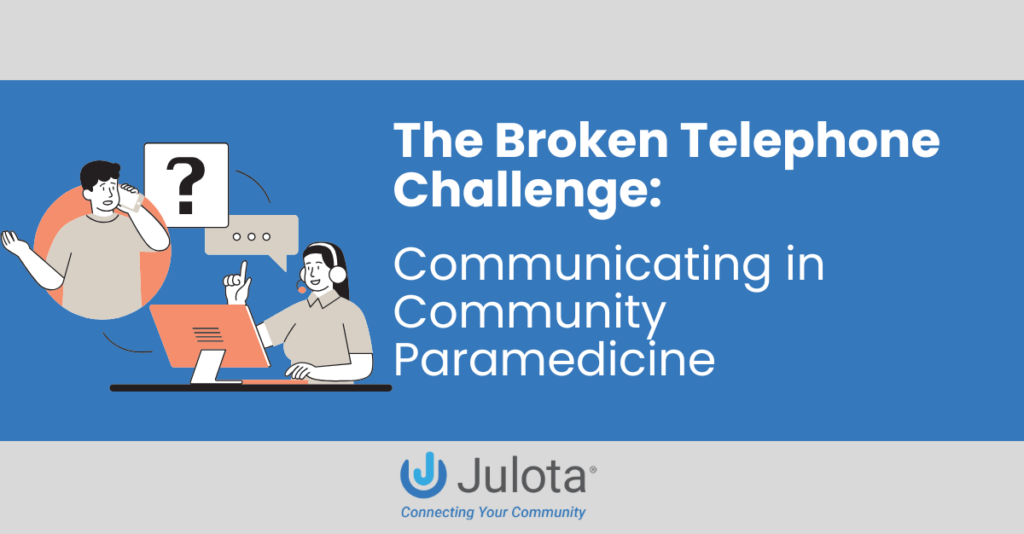The “broken telephone” effect is a well-documented issue in healthcare, where critical information is lost or distorted as it passes through multiple individuals. While this phenomenon is often discussed in the context of emergency medicine, it also poses significant challenges when communicating in community paramedicine.
Community paramedicine is a model that expands the role of paramedics beyond emergency response. In community paramedicine, paramedics work closely with other healthcare providers to deliver proactive care, often focusing on preventing unnecessary hospital visits. However, miscommunication in this model can lead to delayed treatments, misinterpretations of health conditions, and gaps in care coordination. This article will delve into the impact of the broken telephone effect on community paramedicine and ways to minimize it.

The Impact of the Broken Telephone Effect on Community Paramedicine
Communicating in community paramedicine is essential for ensuring patients receive the right care at the right time. However, the transfer of information through multiple parties creates numerous opportunities for errors and inconsistencies. Consider the following scenario:
- A patient with chronic health conditions is enrolled in a community paramedicine program and provides medical history details to a community paramedic.
- The community paramedic documents the information and shares it with a supervising nurse or physician for review.
- The patient’s primary care provider (PCP) requests updates but receives a summarized version of the paramedic’s report.
- The patient visits an emergency room due to a worsening condition, and hospital staff requests a medical history from both the patient and their family.
- Discharge plans are made based on incomplete or inconsistent information due to discrepancies in prior documentation.
At each stage, minor alterations in the way information is conveyed can lead to critical omissions or misunderstandings.
Consequences of Poor Communication in Community Paramedicine
The consequences of poor communication in healthcare are verifiable. A Yale Medicine report highlights that miscommunication leads to medication administration errors, diagnosis delays, and patient care gaps. Furthermore, the HIPAA Journal states that poor communication increases hospital costs due to inefficiencies, readmissions, and unnecessary testing.
The broken telephone effect holds some particular dangers for community paramedics:
- Delayed interventions: If paramedics do not receive a clear picture of a patient’s history, they may not administer appropriate treatments in time.
- Unnecessary hospital visits: Misinterpretations or incomplete documentation may lead to ER visits that could have been avoided with proper outpatient management.
- Medication errors: Patients with chronic conditions rely on accurate medication records. A single misreported detail can result in harmful drug interactions.
- Reduced patient trust: Patients and their families may lose confidence in healthcare providers if they feel they must repeatedly clarify their medical history and concerns.
The Role of Technology in Improving Communication
A key factor in addressing the broken telephone effect in community paramedicine is improving data accessibility and communication infrastructure. Many healthcare providers and emergency services use disparate systems that do not integrate well, making it difficult to ensure a seamless flow of accurate patient information. Some solutions include:
- Electronic Health Records (EHR) Integration: Ensuring that community paramedicine teams have an EHR system that allows them to integrate with an MIH-CP platform to make data more accessible and reduce reliance on frequent voice testimonials.
- Standardized Communication Protocols: Using structured reporting systems and common terminology can help prevent misinterpretations and ensure consistency across providers.
- Mobile and Cloud-Based Platforms: Tools like Julota facilitate interoperability between hospitals, primary care physicians, community paramedics, and social services, ensuring that all parties work with the same up-to-date patient information.
- Real-Time Data Sharing: Equipping community paramedicine teams with access to live updates about patient conditions, recent hospital visits, and prescribed medications can enhance decision-making and prevent redundant questioning.
Enhancing Community Paramedicine Through Effective Coordination
Beyond technology, communicating in community paramedicine requires enhanced coordination among healthcare providers. Strategies to achieve this include:
- Regular case conferences: Holding multidisciplinary meetings to discuss high-risk patients ensures all healthcare providers have the most updated information.
- Training paramedics in health coaching and patient communication: Teaching paramedics to document information clearly, precisely, and easily transferable reduces the risk of miscommunication.
- Encouraging patient participation: Empowering patients to maintain their medical records or use digital health apps can help bridge communication gaps between healthcare providers.
The Future
The broken telephone effect presents a serious challenge to the success of community paramedicine. Community paramedicine teams may struggle to provide effective care without accurate and reliable communication, leading to misdiagnoses, unnecessary hospital visits, and patient dissatisfaction. However, by leveraging technology, like Julota, standardizing communication protocols, and fostering stronger coordination among healthcare providers, we can mitigate the risks of miscommunication.
The future of community paramedicine relies on the integration of seamless data-sharing platforms and collaborative care models. By addressing the challenges posed by the broken telephone effect, we can enhance the efficiency of community paramedicine, improve patient outcomes, and ensure that every healthcare provider involved in a patient’s care has access to the same, accurate information. With a concerted effort to prioritize effective communication, community paramedicine has the potential to transform how healthcare is delivered in the community setting, reducing hospital strain and ultimately saving lives.